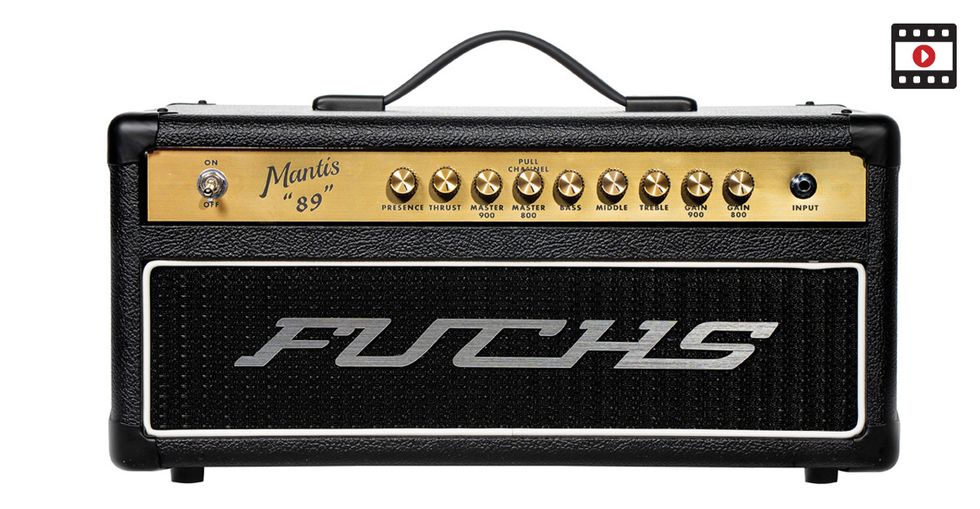RatingsPros:Great build quality. Very convincing ’80s and ’90s Marshall-inspired rock tones. Surprisingly good plexi-style sounds. Cons: Switching between channels can make the amp too dark or too bright at some shared EQ settings. Street: $1,850 Fuchs Mantis 89 fuchsaudiotechnology.com | Tones: Ease of Use: Build/Design: Value: |
Andy Fuchs’ New Jersey-based amplifier company broke through in the early aughts on the strength of excellent Dumble-inspired designs. But subsequent amps that satisfied the thirsts of heavier rockers were hits, too. The original Mantis 100 of the early 2010s was one such creation: a fierce, fire-breathing beast that ranged from gut-thumping, American-voiced sounds to all-out scorch-and-burn.
The new 50-watt, EL34-powered Mantis 89 reviewed here roars with equally raucous attitude, yet it takes its sonic cues from the other side of the Atlantic. The “89” refers, obliquely, to its primary inspirations—the Marshall JCM 800 and 900 series, and it’s configured as a 2-channel amp that can switch between 800 and 900-style sounds.
Panel for Gold
Though its punching power suggests bigness in every respect, the Mantis 89 is a stout and relatively compact bulldog of a head. It measures 18.5" x 11" x 8.5" and weighs 38 pounds. The black vinyl, brushed-gold control panel, gold-tipped knobs, and white piping all nod at Marshall’s influence. But the circuit isn’t just a slavish reproduction of the British heads that inspired it.
A shared 3-band EQ stage keeps the multi-functional control panel down to a tidy nine knobs, which admirably perform the two-amps-in-one duties required here. The 800 and 900 channels each have dedicated gain and master volume knobs, but they share controls for thrust (a bass frequency control often known as “depth” or “resonance” on other amps) and presence, which tweaks the high and high-mid frequencies at the output stage.
The back panel is home to a few essential features. Three speaker outs offer options for 4-, 8- and 16-ohm cabinet configurations. There’s a TRS effects loop send/return jack (meaning you’ll need a TRS Y-cable to tap it), and a jack for the included two-button footswitch, which also features a preset boost function. The standby switch is also on the back panel, although the main power switch and indicator light are on the front.
In addition to the EL34s in the output stage, the amp uses three 12AX7s for preamp and phase-inverter duties. The circuit itself is built around quality components hand-mounted on a thick, sturdy PCB. A fan mounted behind the output tubes helps keep the big bottles cool. It can seem a little noisy when you’re up close, but playing at even low volumes obscures the sound of the fan whirring away.
Playing Mantis
The Mantis 89 lays down a fast and wide track to a range of arena-rock tones. And while you can summon distinctly ’80s and ’90s-style high-gain tones, there are many available sounds that sound classic and not at all dated.
Fuchs doesn’t specify which JCM800 the 800 channel is derived from, but it sounds great. It’s no one-trick pony either: You can easily get sounds that evoke more “classic” Marshalls like the 2204 Master Model circuit and the 1987 plexi. In general, when you reduce the gain and roll the master volume up, you get chunky edge-of-breakup plexi tones. Crank the gain, though, and the classic-rock lead tones get sizzling quick.
The 900 channel, on the other hand, is all fire and brimstone, and an utter blast when those moods strike you. It can be dialed back for mild crunch, but that’s not where the 900 channel feels most natural. Instead, it’s happiest cranking out hair-metal saturation, classic ’90s shred tones, and more contemporary high-gain grunge textures. And there’s plenty of crispy high-end crackle, midrange grind, and low-end thump on tap that you can use to tailor those textures for your own creative needs.
I found the boosted setting particularly delectable on both channels. In addition to the added gain (or perhaps because of it), it delivers an increased sense of size and saturation at the same time that never collapses into a compressed mess. The very effective EQ section gives you a lot of frequency shaping power, too—which is enhanced by the capable presence and thrust controls. And to my ear the thrust control actually helps the Fuchs generate more low-end oomph than either of the models that inspired it. The master volume controls work well on each channel, too. And it’s not inconceivable that you could use the amp in a 50-seater club, if necessary. The powerful EQ does make the otherwise convenient act of channel switching tricky at times. Identical settings that are ideal for one channel may not be completely suited for the other. And a few settings I liked either made the 800 channel too dark or the 900 too bright for my tastes. A bright switch for the lower-gain 800 side might be a good fix.
The Verdict
Like every Fuchs creation I’ve experienced, the Mantis 89 is extremely well built and well thought-out. It’s a super-functional reinvention of two heavy-rock-staple amps, and there’s more than enough power here for big gigs. But the extremely usable master volume controls keep it sounding fat and fierce at club volumes. And while I’d love to see some footswitchable means of brightening up the 800 channel independent of the hotter 900, there is, otherwise, very little to fault in this superb amplifier.
Watch the Review Demo:








![Rig Rundown: Russian Circles’ Mike Sullivan [2025]](https://www.premierguitar.com/media-library/youtube.jpg?id=62303631&width=1245&height=700&quality=70&coordinates=0%2C0%2C0%2C0)


























